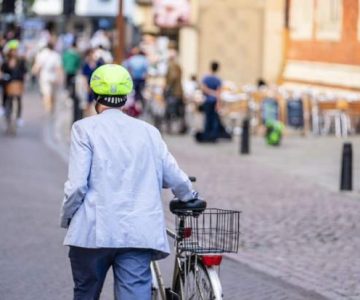The roads in the UK are amongst the safest in the world. People generally drive on the right side of the road (even if it is on the left) and stick to the rules. Brits love cycling and the whole country is currently undergoing a cycling renaissance, there has never been a better time to head to the UK for some cycling. However, thousands of people die in road traffic accidents on UK roads every year, so it pays to be safe.
Brits Drive on the Left Side of the Road!
Unless you come from many of the commonwealth countries, you will have almost certainly have grown up with driving and cycling on the right-hand side of the road. Brits however drive on the left-hand side, so you may have to spend some time adjusting to our roads before you can be confident on them. If you haven’t the time or funds to spend on some cycle training, spending an hour or two cycling on some quiet roads in a residential area will help you feel good about the strange turnings and rules.
The Highway Code is too complex to go into in this short article, but we strongly advise you read it thoroughly and highlight differences to your home nation’s rules. The Brits are a law abiding bunch and take road safety very seriously, so if you are not obeying the laws of the road, you can expect to be stopped by the traffic police, or at least shouted at by a guy in a white van.
Many accidents happen in the UK because a cyclist is trapped on the inside of a vehicle that is turning left. Never assume a vehicle will go straight, they do not always indicate. If there’s a turning, stay visible and behind the vehicle until it has passed. This happens mostly at junctions. Be aware that larger vehicles turn right before turning left, giving you a false sense of security.
Watch the Road
For whatever reason, a lot of access covers (the metal plates in the road) are placed right in the middle of the road, especially on turns. This seems to be a particularly British thing. When you’re cornering, keep an eye out for the panels when it is wet, you might find yourself in a ditch at the side of the road otherwise.
Get fit before you arrive
Being unfit does not just spoil a holiday because you can’t keep up, it is dangerous. You do not want any part of your body to fail when you are in thick traffic, or heading down a winding path at 50 miles per hour. Nobody is asking you to be Olympic level fit, but you should have any existing medical issues resolved or being effectively treated before you embark on a cycle trip anywhere. You keep yourself and everyone else safe by being in good condition.
Accidents happen. If you do get injured, you can go to any UK hospital and receive immediate treatment whether you have insurance or not (see below).
Get Some Insurance
Although the UK is a relatively safe place to cycle, there is a lot of traffic and the conditions of the roads are not as high as we might like. If you’re from abroad, having insurance coverage is a must. While UK residents can enjoy the services of the NHS for free, it costs money to access NHS services for non-residents. You will not be turned away from a hospital because of a lack of insurance but the bill might be large when it arrives in a few months’ time.
There’s also the issue of personal injury. If you have a road traffic accident and injure another person you may find they file an RTA claim against you to compensate them financially for pain and suffering and potential costs and expenses. Talk to your insurer, ask for full accident coverage.
Have a Plan and Plan Ahead
If you fail to plan, you plan to fail. Keeping everyone safe requires everyone to know what the plan is, what the destinations are, timings, and what to do if someone gets lost or gets injured.
If you and your team have a plan and a destination, you can avoid heavy traffic and risky areas for cyclists. This will not only make your trip much more pleasant but it will also help you to keep safe. Avoiding the Manchester rush hour or London’s morning gridlock will reduce your chance of accidents and ensure you see the nice parts of the UK, not just the bumpers of endless fume-belching cars.
Maintain your Bike
The UK has no shortage of excellent bike supply and repair shops. In London alone, there are over 300. You have a legal obligation to make sure your bicycle is in road-worthy state, so make sure your brakes work, your tyres are pumped up, and you have lights for night and heavy weather riding. A quick internet search will show you the local bike repair shops if you need supplies or to fix something. Prices are reasonable, the service is usually excellent, and you can save yourself a lot of trouble by keeping your bike in top condition.
Be Visible
The great nations of the British Isles are northerly, so it gets dark in winter early. Even if you are only cycling during the day, ensure you have a reflective jacket or reflective stripes on your clothes. You NEED lights on your bike, like everywhere else.
When you’re cycling on roads, make sure you are visible to motorists. Stay out of blind spots and keep your distance from large vehicles. A good tip is to make eye contact with motorists when you are stopped at a junction so you know they have seen you. The last thing any cyclist wants is to be a cyclist injured in an RTA.
Wear a Helmet
If you don’t wear a helmet because you don’t think it looks cool, get over it. All the local cyclists will look at you if like you’ve gone mad if you don’t wear one. Pick one up at a local bike shop for around £25.
Buy a Bell
A bell can save you a lot of trouble. It will alert pedestrians and motorists to your approach and allow them to get out of the way if you’re going fast. They cost very little and can save a lot of money and pain.
Talk to the Locals
Cycling communities are very friendly in the UK and we love people coming from abroad to enjoy our lovely little island, so don’t be afraid of introducing yourself to fellow cyclists. They will help you find the best cycling around their area and help you stay safe by avoiding certain areas. Local knowledge is essential.
Tell People where and when you are going
The UK can be surprisingly remote for an island with so many people on it. It is easy to get lost, even though there are so many signs everywhere, and solo riders could find themselves in a lot of trouble in a variety of ways. Just to be safe, tell someone when and where you are going and check in with them when you have arrived. The UK has low levels of crime compared to many countries but it is better to be safe than sorry, as we say.
For groups, it is easy to get lost on the thousands of winding roads and paths in the UK. Make sure everyone knows what the rally point is and has a way of communicating with everyone else should they get lost or have an accident. If someone does not turn up and you cannot get hold of them, you can call the emergency services on 999.
In an Emergency, Call 999
The number for the emergency services in the UK is 999.
For Non-Emergencies, Call 111
The NHS helpline number is 111. For all non-emergencies and for advice, call this number. The help is very high quality, if in doubt, call them.











